Delosperma gautengense
Delosperma gautengense H.E.K.Hartmann
Family: Aizoaceae
Common names: Gauteng delosperma, gold reef sheepfig (Eng.)
Introduction
The Gauteng delosperma is a succulent plant native to rocky outcrops of the Magaliesberg in South Africa, it dazzles with its radiant, white, daisy-like flowers that burst into flower in spring and summer.
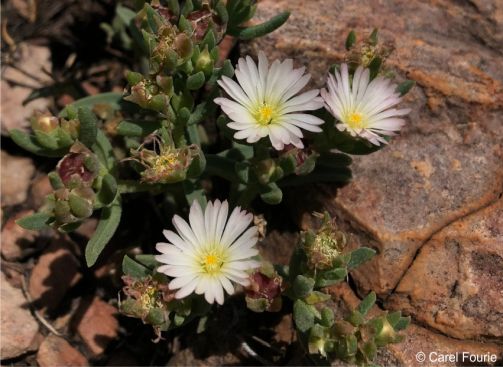
Description
Description
Delosperma gautengense is a herbaceous perennial succulent that forms loose cushions with 5-8 thin, nearly upright, spreading annual branches growing from the top of a thick, irregularly shaped taproot. These plants can reach up to 200 mm in height and 400 mm across, and feature prominent bladder cells on the stems, pedicels and fruit bases. The leaves spread out and widen from a narrow base to a pointed tip, measuring 45–50 mm long, 6–7 mm wide at the base, and 4–5 mm thick in basal position. Bladder cells along the margins are elongated, especially near the leaf base. Individual flowers reach 25 mm in diameter, bearing about 22 petals that are white with a tinge of mauve on the under sides, resembling porcelain when closed. The fruit is a capsule, about 5 mm in diameter. The flowering period for Delosperma gautengense is in the spring and summer months in South Africa’s subtropical climate.
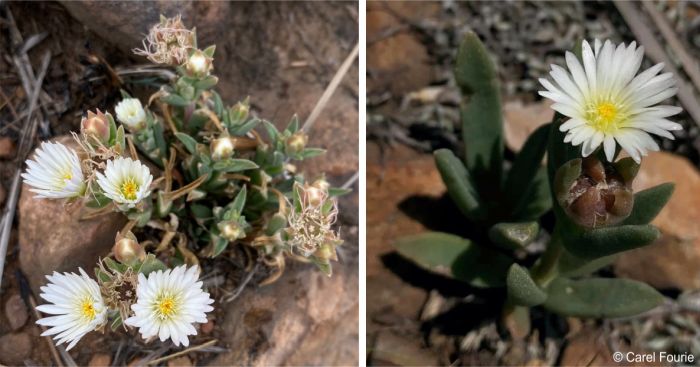
Conservation Status
Status
Delosperma gautengense is assessed as Vulnerable (VU) on the Red List of South African Plants because the species is currently facing the potential threats of habitat loss and degradation caused by infrastructure development, overgrazing, invasive alien plants and inappropriate fire management.
Distribution and habitat
Distribution description
Delosperma gautengense is endemic to Gauteng, South Africa. It can be found growing in Gold Reef Mountain Bushveld and Gauteng Shale Mountain Bushveld amongst rocks on south-facing slopes in the Magaliesberg.
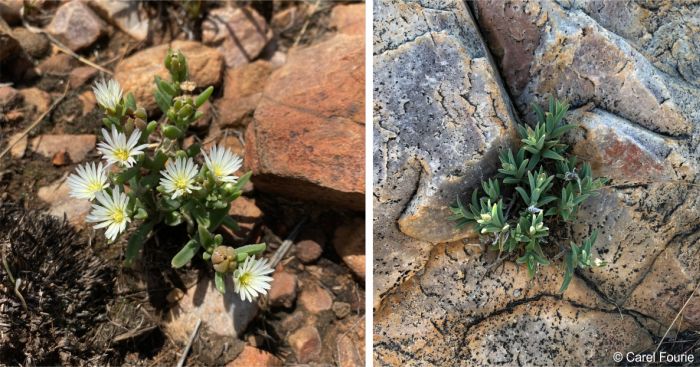
Derivation of name and historical aspects
History
The genus name Delosperma is derived from the Greek words delos, meaning ‘evident’ or ‘visible’, and sperma, meaning ‘seed’. This refers to the exposed seeds of the plant that are visible in the fruiting capsule. The species name gautengense means ‘from Gauteng’, the province in South Africa where the plant is native and commonly found. The combination of these names highlights both the plant’s distinct seed characteristics and its regional origin.
Delosperma gautengense is part of the Aizoaceae, commonly known as the ice plant family. The Aizoaceae comprises approximately 1 800 species, spread across more than 130 genera and are primarily found in arid and semi-arid regions of the world, particularly in southern Africa. The family is known for its succulent nature, which is an adaptation to conserve water in dry environments.
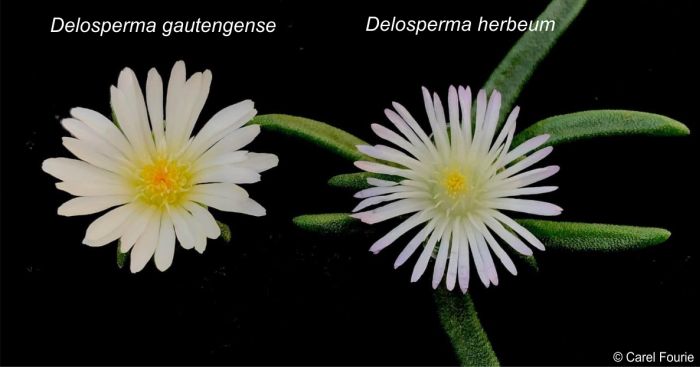
Ecology
Ecology
Delosperma gautengense is an important component of vegetation in the arid and semi-arid region where it occurs. As a succulent, D. gautengense has evolved to store water in its leaves and stems, enabling it to survive extended periods of drought. Its thick, fleshy leaves also minimize water loss by reducing surface area and stomatal openings. The plant is capable of growing in nutrient-poor soils, and is often found in rocky terrains. Its root system is adapted to anchor the plant firmly into the crevices of rocks, providing stability and accessing moisture from deeper soil layers.
The bright flowers attract various pollinators, including bees and other insects. This mutualistic relationship ensures the plant's reproductive success while providing food resources for the pollinators.
Delosperma gautengense plays an important ecological role in its ecosystem by stabilizing soil and reducing erosion in its rocky habitat. It also provides habitat and food for various insects and small animals.
Uses
Use
Delospermas are highly valued for their ornamental qualities, their vibrant, daisy-like flowers and succulent foliage make them a popular choice for rock gardens, borders and container gardening. D. gautengense, with its its ability to form dense mats makes an excellent ground cover, which can enhance the aesthetic appeal of gardens and landscapes.
While specific medicinal uses of D. gautengense are not documented, many plants in the Aizoaceae family have been used traditionally for their potential healing properties. Further research may reveal more about the medicinal applications of this particular species.
Growing Delosperma gautengense
Grow
Delosperma gautengense is an easy plant to grow and can be propagated from seeds or cuttings. It is a recommended plant for rock gardens and container planting. It is ideal for rock gardens due to its low-growing, spreading habit and tolerance of poor soil. It can also be used as a ground cover for sunny, well-drained areas. As it is a low-maintenance plant, it is a good choice for gardeners.
Sow seeds in spring or early summer, in a well-draining seed mix, lightly covering them with a thin layer of sand or fine soil. Keep the soil moist but not waterlogged. Take healthy, non-flowering stem cuttings in spring or early summer, and allow the cut ends to dry for a few days before being planted in well-drained soil. The plant requires full sun to partial shade to thrive. It is drought tolerant and does not require frequent watering, water only when the soil has dried out completely.
References
- Hartmann, H. 2001. Illustrated handbook of succulent plants. Aizoaceae, A-E. Springer, Berlin.
- Victor, J.E. & Pfab, M.F. 2005. Delosperma gautengense H.E.K.Hartmann. National Assessment: Red List of South African Plants. http://redlist.sanbi.org/species.php?species=137-213.
Credits
Rofhiwa Ingrid Mudau
Pretoria National Botanical Garden
February 2025
Acknowledgments: the author thanks Mmapaseka Ledwaba. Images by Carel Fourie.
Plant Attributes:
Plant Type: Succulent
SA Distribution: Gauteng
Soil type: Sandy, Loam
Flowering season: Spring, Early Summer, Late Summer
PH:
Flower colour: White
Aspect: Full Sun, Morning Sun (Semi Shade), Afternoon Sun (Semi Shade)
Gardening skill: Easy
Special Features:
Horticultural zones
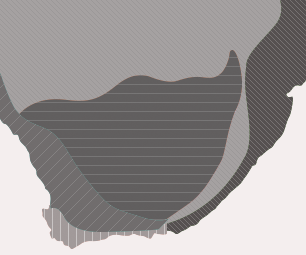










Rate this article
Article well written and informative
Rate this plant
Is this an interesting plant?
Login to add your Comment
Back to topNot registered yet? Click here to register.